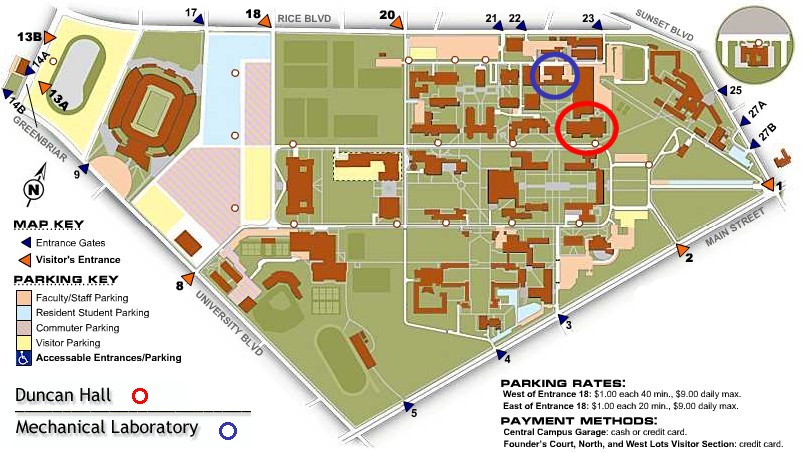| Details
Severe Storm Prediction, Education and Evacuation from Disasters
Symposium Theme
Experts from academic, public, and private sectors will discuss technical, social, and economic issues associated with tropical storms and hurricanes in Gulf Coast communities. This conference is a follow up to the March 2006 conference at Rice University on "Severe Storms Impact and Disaster Response".
Conference participants will address, among other questions;
- Flood Prediction and Flood Alert
- Advanced Technology & GIS
- Land Use in the Coastal Zone
- Evacuation Planning in Texas
- Evacuation Planning from Disaster
- Impacts on the Gulf Coast
- Coastal Surge Modeling & Impacts
- Critical Facility Needs
- Flood Inundations Zones and Floodplains
- Education & Societal Outreach
Conference Costs
General Conference, May 8 – May 9, 2007
• Symposium: $200
• GOV and NGO: $100
• Student: $20
Short Courses
• Short Course: $50 each
1. " Introduction to HEC-RAS: Fluid Mechanics without a Wrench", Matt Zeve, Dodson & Associates Inc.
May 10, 2007 08:00 - 12:00
Open channel hydraulics and water surface profile calculations are essential parts of any flood plain determination and flood study. This seminar will provide an overview of hydraulic modeling and analysis through the use of the HEC-RAS software package. The seminar will focus on demonstrations of creating and reviewing models. This seminar will cover concepts for common hydraulic modeling tasks. These include setting up a HEC-RAS model, introducing the modeling parameters, channel modifications, culvert and bridge modeling, floodway delineation, reviewing results, and output analysis. The use of both the steady and unsteady flow options will be discussed.
HEC-RAS is quickly becoming the primary tool that water resources engineers use for open channel hydraulics and is the software used to map the majority of the floodplains and floodways in the United States. The purpose of this seminar is to gain a working knowledge of commonly used features of the software.
2. "Introduction to Radar Rainfall and Distributed Stormwater Modeling", Baxter Vieux, University of Oklahoma.
May 10, 2007 13:00 - 17:00
Use of hydrologic prediction technology can help mitigate the impacts of severe weather and hurricanes on inland flooding. Technological advances in radar rainfall detection and distributed hydrologic modeling make it possible to provide real-time stormwater and emergency management information. These applications can be used to design more effective drainage infrastructure and to develop flood hazard mitigation action plans.
Topics covered in this training seminar include, radar rainfall estimation, distributed hydrologic prediction of stormwater, and applications in real-time prediction and analysis of storm events.
Training Topics:
- Introduction to NEXRAD Radar and Background
- Radar Theory and Rainfall Estimation
- Distributed Hydrologic Prediction of Stormwater
About the Organizers
Dr. Philip B. Bedient, Ph.D., P.E.
 |
Philip Bedient is a Professor of Civil and Environmental Engineering at Rice University, and holds the Herman Brown Chair in Engineering. He has been studying urban hydrology for the past 30 years, including major floodplain studies, stormwater studies, water quality studies, and radar-based flood alert systems for Texas. Dr. Bedient is lead author of a textbook entitled "Hydrology and Floodplain Analysis", used in over 70 universities.
http://fas2.rice.edu
bedient@rice.edu |
Dr. Baxter E. Vieux, Ph.D., P.E.
|
Baxter Vieux is a Professor of Civil Engineering and Environmental Science at University of Oklahoma. As Director of the Center for Natural Hazard and Disaster Research, he oversees research efforts to mitigate severe weather impacts such as flooding. He is an expert in the development of engineering hydrologic applications using NEXRAD radar. His active research programs focus on distributed-parameter hydrologic modeling and advanced hydrologic applications of NEXRAD weather radar prototyped at the National Severe Storms Laboratory (NSSL), Norman OK.
http://nhdr.ou.edu/
http://www.vieuxinc.com/
bvieux@ou.edu |
Directions to Rice University
From George Bush Intercontinential
Airport
From William P. Hobby Airport
Directions to Duncan Hall for the Conference
The symposium will be held in the McMurtry Auditorium, in Duncan
Hall on the Rice University Campus. The map below shows Duncan
Hall circled in Red and parking information.
Directions to Mechanical Laboratory for the Short Courses
The Short Courses will be held in the Mechanical Laboratory
Hall on the Rice University Campus. The map below shows Mechanical Laboratory
circled in Blue and parking information.
Parking at Rice
For more information about parking,
including rates, go to the Rice
University Campus Maps page. This site has maps of campus,
including parking and shuttle information.

|











